The OKR cycle [guide + best practices]
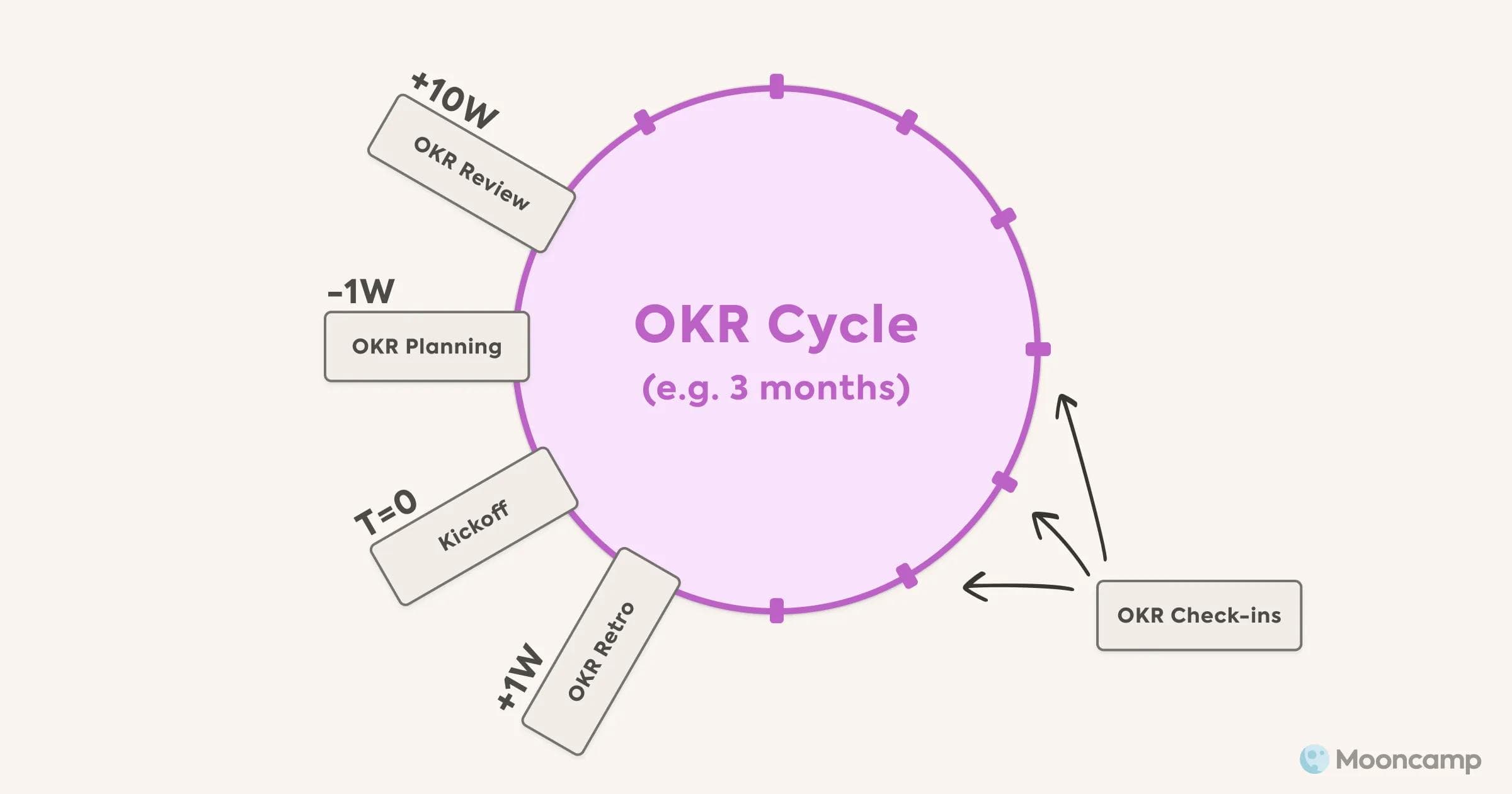
The OKR cycle is the heart of the entire OKR framework. In this article, we explain step-by-step how it works in detail. We also reveal proven best practices to successfully navigate challenges during the OKR cycle.
What to expect:
- What is the OKR cycle?
- The OKR cycle in detail
- Challenges in a typical OKR cycle (and how to overcome them)
- What role does Mooncamp play in the OKR cycle?
- OKR cycle: FAQ
💡 Note: OKRs (short for "Objectives and Key Results") are an agile framework for formulating and implementing strategic goals in companies that - if used correctly - leads to more flexibility, transparency and success. It consists of three core elements:
- Objectives: What do I want to achieve?
- Key Results: How do I know that the goal has been reached?
- Initiatives: How do I achieve the goal?
A total of 2 to 4 Objectives per team and 2 to 4 Key Results per Objective are formulated. The output is mapped into initiatives (= concrete activities). More basic knowledge is available in our OKR guide.
What is the OKR cycle?
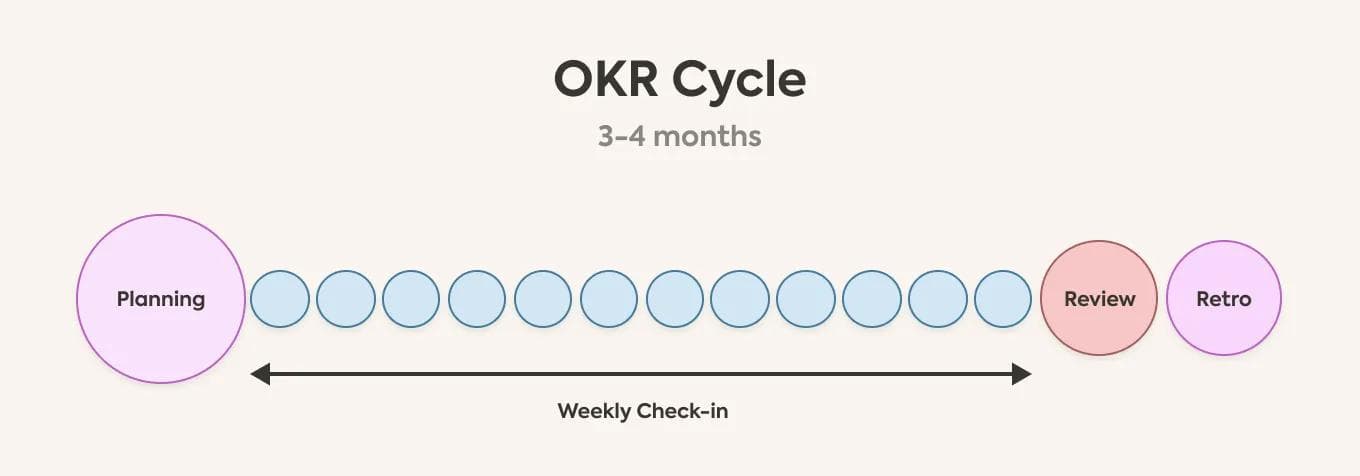
The time period that is set for the implementation of OKRs is called the OKR cycle. Most often, an OKR timeline of three months (a quarterly OKR cycle) is chosen. However, 4-month or 2-month cycles are also conceivable, depending on what suits the company better. Various events take place within an OKR cycle:
- Planning
- Weekly (OKR check-in)
- Review
- Retrospective
OKR Planning takes place before each cycle. All teams plan their OKRs for the next iteration. The OKR Weekly (or OKR check-in) is a weekly exchange where teams discuss the current status of their Key Results. Each OKR cycle culminates in an OKR Review. This is a meeting where employees present the final status of the OKRs for that cycle. An important last step in the cycle is the OKR Retrospective: This is a reflection on the entire OKR process at a meta-level and a review of where the process needs to be adjusted in the next OKR cycle.
The OKR cycle in detail
In order to understand the OKR cycle in more detail, we will now look at each event within the cycle step by step:
1. OKR Planning
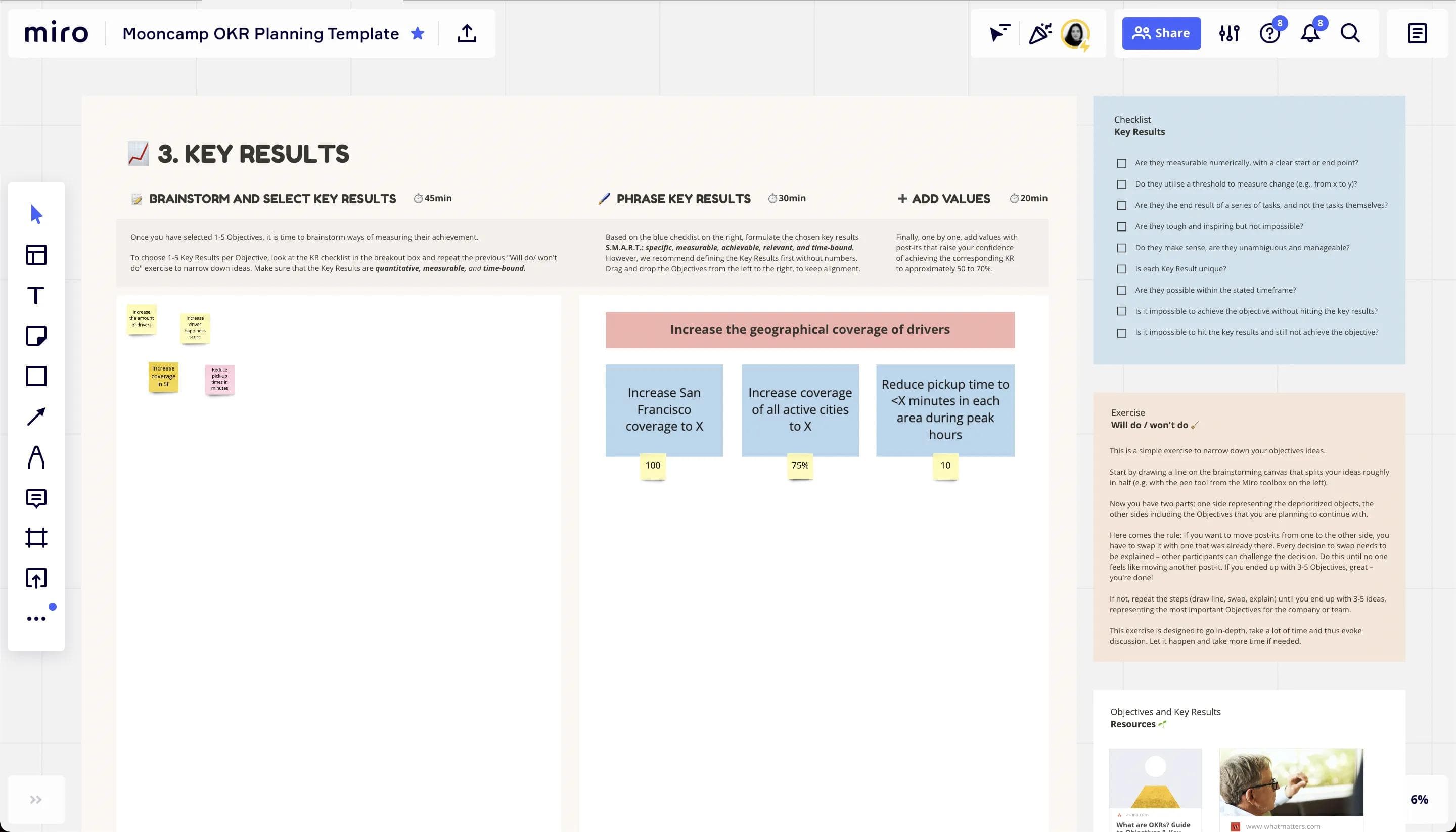
Before agile teams begin implementing their tactical quarterly Objectives and Key Results, management establishes enterprise-level OKRs in OKR Planning. This planning phase occurs prior to each OKR cycle. On average, planning takes about 2 to 4 hours per team. With the established top-line company OKRs as a guide, teams now begin to develop their individual OKRs in a stand-alone planning.
💡 Tip: Our Miro OKR Planning Template helps create OKRs and brings structure to planning. If you're already a step ahead, check out these tips for writing effective Objectives and Key Results.
2. OKR Weekly

The OKR Weekly is a weekly check-in that addresses the following questions:
- What is being worked on right now?
- What is the status of the Key Results?
- Are there any roadblocks blocking the progress?
The focus is always on actually achieving the Key Results at the end of the OKR cycle. Check-ins are an essential part of the OKR process and ensure that everyone is tracking and sharing their progress regularly.
💡 Tip: With Mooncamp, all check-ins are in one place. A handful of targeted questions and recurring reminders provide structure and ensure that OKRs are adopted and always top of mind.
3. OKR Review
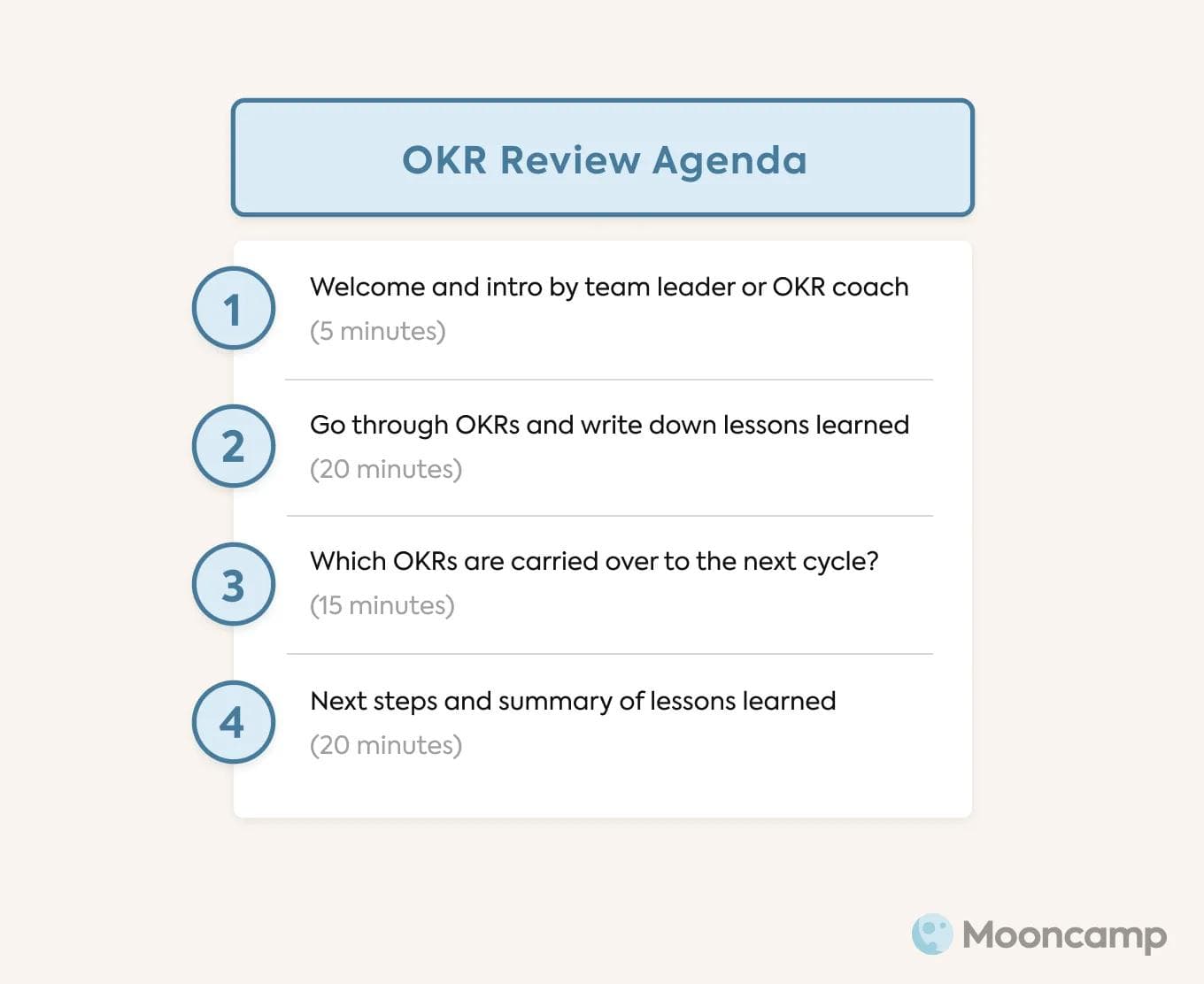
At the end of each cycle, an OKR Review is held. On this occasion, all teams present the final status of the OKRs for the cycle.
The OKR Review is primarily concerned with the following aspects:
- Were the goals met?
- Were the goals set too high (or too low)?
- What are the results to date?
- Where are there opportunities for improvement?
4. OKR Retrospective
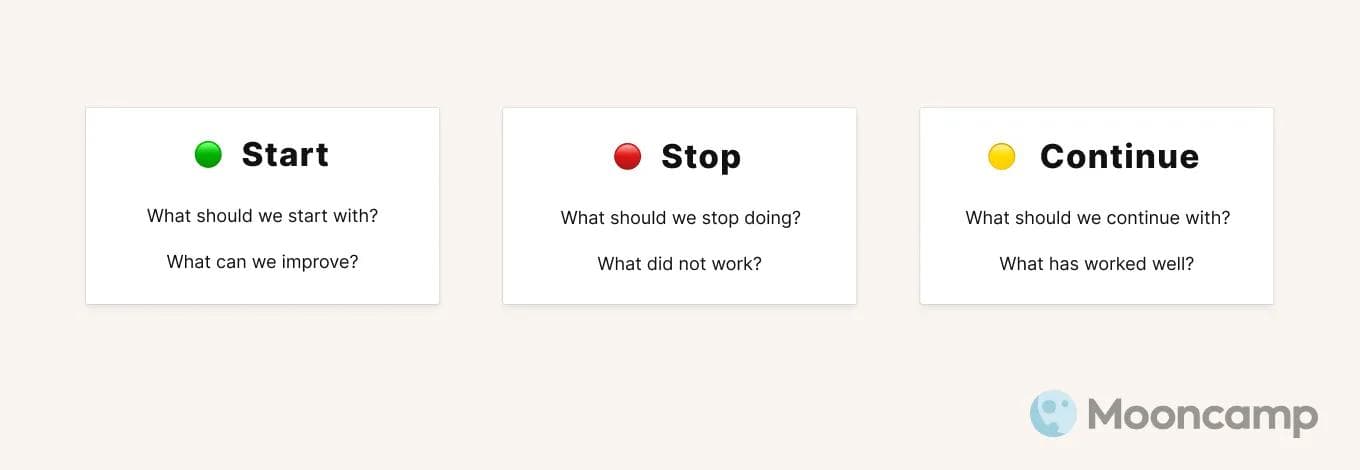
Like the OKR Review, the OKR Retrospective usually comes at the end of the OKR cycle (or right at the beginning of the new cycle). The difference: While the review covers the content, i.e. the status of the OKRs, the OKR Retrospective methodically reflects the OKR process on a meta level and determines potential for improvement.
In the OKR Retrospective, the full agile potential of the OKR framework unfolds. All parameters in the OKR process, such as the length of the cycle or the structure of the check-ins, are reflected upon and – if necessary – adjusted until they exactly fit the needs of the company.
The “start/stop/continue” method provides a good structure for retrospectives:
- Start: What should we start doing? (What can we improve?)
- Stop: What should we stop doing? (What did not work?)
- Continue: What should we continue doing? (What has worked well?)
Challenges in a typical OKR cycle (and how to overcome them)
Especially if the OKR method is new in the company, there are usually some challenges in the first OKR cycles. These include unclear OKRs or lack of employee participation. We have compiled some of the most common problems and provide practical tips and tricks on how to still get through an OKR cycle as smoothly as possible.
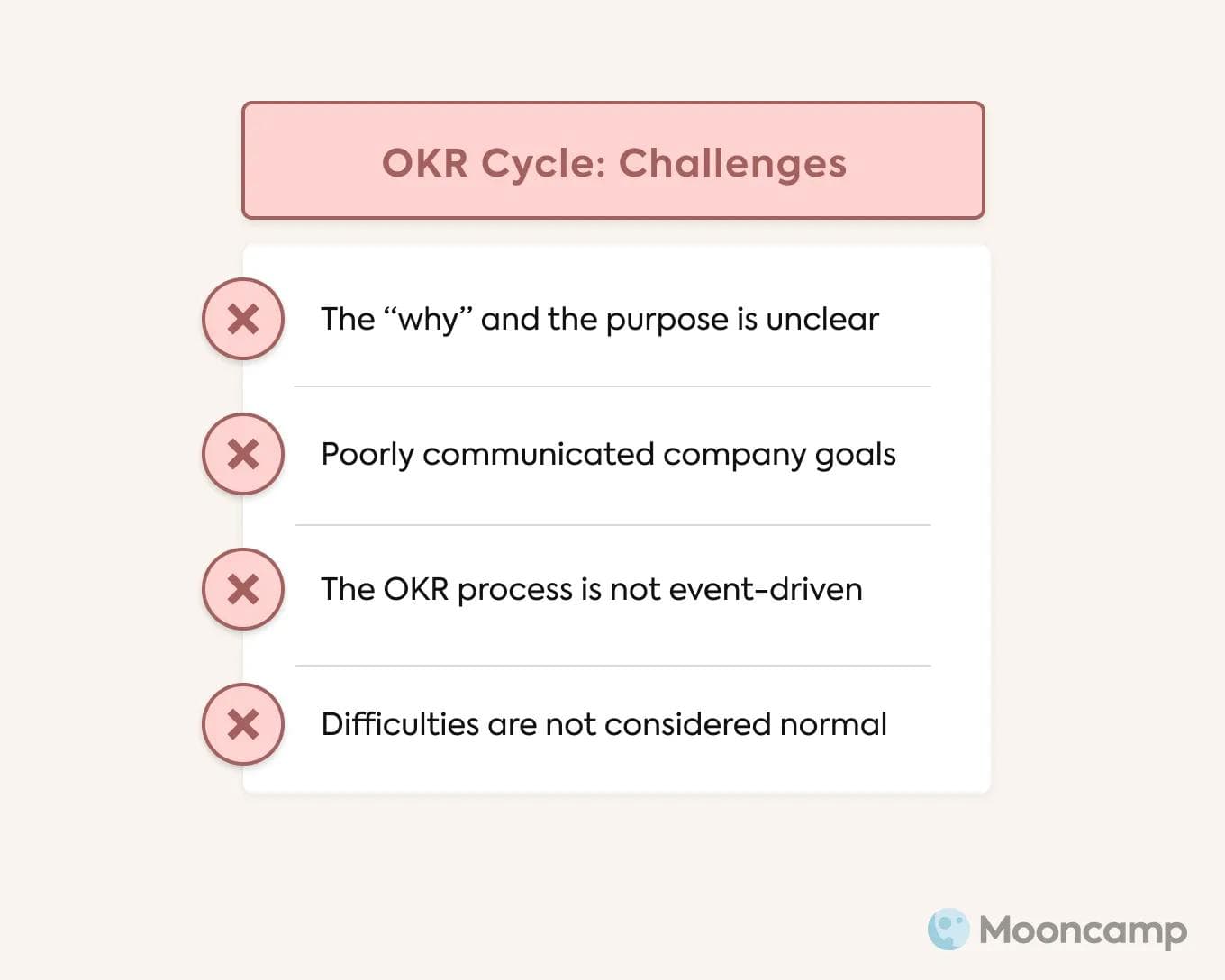
1. The “why” is unclear
The OKR process consists of many individual steps. Committing to an entire OKR cycle therefore requires a high level of motivation and ownership. To ensure that OKRs are not perceived by employees as additional work, the “why” should always be obvious.
✅ The solution: It is important to explain why each step in the process serves a specific purpose. At the same time, teams should be invited to share their ideas for improving events in the OKR cycle at any time. To this end, for example, interactive info sessions should be held at kick-off, where employees are encouraged to ask questions. Training and info materials, available online, help remind people of the “why” during implementation. Feedback should be actively solicited, for example in the form of short surveys.
2. The team is not accurately informed about the business objectives
Everyone in the team should always be informed about the cross-team OKRs as well. This helps employees understand what to do, when to do it, and what purpose it serves. Otherwise – if the overarching goals or even the methodology are unclear – engagement can quickly slacken.
✅ The solution: Top management should discuss the company-wide OKRs with the teams. One way to do this is to first present the OKRs to all employees (e.g., in an all-hands meeting). Afterwards, the individual teams, initiated by the team leads, should discuss the OKRs again specifically in order to clarify questions. In addition, feedback and ideas on how best to achieve the goals should be actively encouraged, for example through a strategy session in the team or one-on-one talks.
3. The OKR process is not event-driven
An event-driven process can go a long way toward making agile goal management a regular routine for all employees. If the individual events in the OKR cycle are not committed appropriately, a results-oriented work routine cannot form.
✅ The solution: Teams should celebrate all events (e.g., the OKR kick-off) and successes during a cycle, for example, by posting a channel in MS Teams or Slack when a significant milestone is reached. In addition, the regular check-ins should not only discuss roadblocks and problems. There should always be room on the agenda for achievements as well.
4. Difficulties are not considered normal
Teething troubles at the beginning of OKR implementation are common and part of the process. It can take time to adapt all aspects of working with OKRs to the individual organizational context. In the process, it is normal to stumble in the beginning and find the first cycles chaotic as inefficiencies and performance issues in the organization are uncovered.
✅ The solution: Keep at it, reflect on mistakes and see them as opportunities to learn. The OKR process is designed from the ground up to be continuously adjusted. Retrospectives are essential to discuss challenges and gain practical insights. In addition, an OKR cycle should usually not last longer than 2 to 4 months. This allows you to react directly to inconsistencies and adjust it in the next cycle.
What role does Mooncamp play in the OKR cycle?
The path to efficient and successful OKR cycles comes with some challenges. But those who seek support before and during the implementation of the OKR framework can only benefit in the end. The practical implementation is particularly easy with a suitable OKR software.
Mooncamp offers, among other things, the possibility, to
- visualize OKRs so that everyone can see how OKRs contribute to company goals,
- track OKR progress for each cycle and work collaboratively on goals,
- conduct structured OKR plannings,
- configure custom OKR cycle lengths according to your needs,
- analyze OKR progress in Performance dashboards),
- get insights about the health of OKRs (Health dashboard
- set up recurring reminders for each event in the OKR cycle,
- use collaboration tools (like Slack or MS Teams) and update OKRs from there.
This allows all employees to focus on what's really important: achieving their goals.
OKR cycle: FAQ
Is OKR an agile methodology?
Yes, OKRs belong to the agile methods. The focus is on agile goal management, which connects the overall goals of the organization with those of the individual teams. OKRs can be used to create alignment, track progress, and increase employee engagement.
What is an OKR process?
An OKR process is made up of several events. The OKR cycle (which typically lasts three months) consists of OKR Planning, regular check-ins, and finally an OKR Review and OKR Retrospective. All of these events repeat each cycle and describe the OKR process.
How do you write OKRs?
OKRs consist of two to four inspirational, qualitative and directional Objectives per team. These answer the question of what you want to achieve. In addition, two to five measurable, specific and time-bound Key Results are defined for each Objective. These express how you can tell that the goal has been achieved.
